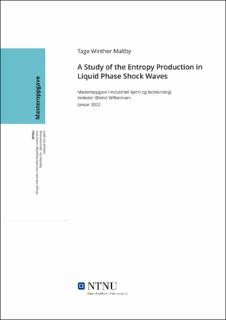| dc.contributor.advisor | Wilhelmsen, Øivind | |
| dc.contributor.author | Maltby, Tage Winther | |
| dc.date.accessioned | 2022-05-30T12:24:25Z | |
| dc.date.issued | 2022 | |
| dc.identifier | no.ntnu:inspera:103300842:14498170 | |
| dc.identifier.uri | https://hdl.handle.net/11250/2996851 | |
| dc.description.abstract | Vi har simulert en sjokkbølge i væskefase ved bruk av Non-Equilibrium Molecular dynamics (NEMD) og Navier-Stokes (N-S) ligningene. Den nye anvendelsen av N-S ligningene kombinerte en tilstandslikning (EOS) for et Lennard-Jones/spline (LJ/s) fluid, en transportkoeffisientligning for argon, den romlige FORCE-fluksen og en ordinær differensialligning (ODE) integrator for å løse et dynamisk sjokk. De to metodene ga lignende profiler, men hadde noen karakteristiske forskjeller. N-S likningene hadde en skarpere sjokkfront, lavere målbar varmefluks og lavere temperatur der sjokket ble skapt. Den skarpere sjokkfronten, sammenlignet med NEMD og eksperimentelle metoder, har vært karakteristisk for N-S-ligningene i tidligere arbeid.
Ved å utnytte simuleringsdataene ble sjokkbølgeegenskaper funnet. Først ble posisjonen til sjokkbølgen bestemt ved å bruke definisjonen av Gibbs ekvimolare overflate. Lydhastigheten ble bestemt til å være 4.7 ved bruk av tilstandslikningen. Mach-tallet ble beregnet for begge metodene, og viste at bølgen beveget seg med M ≈ 2. Excess indre energi- og entropitetthet ble bestemt og overflatetemperaturene ble bestemt til å være 3.2 for N-S ligningene og 2.82 ± 0.184 for NEMD-simuleringene.
Excess entropiproduksjon av sjokkbølgen ble bestemt ved hjelp av fem forskjellige metoder, inkludert en nyutviklet metode kalt Macro Entropy Method (MEM). Alle metodene ga lignende resultater ved bruk av N-S ligningene, mens metodene fluktuerte mer for NEMD-simuleringene. Det ble også observert at N-S ligningene hadde en lignende excess entropiproduksjon som NEMD-simuleringene, selv om N-S-ligningene ikke inkluderte bulkviskositet. Dette ble diskutert i detalj, der noen av hovedpunktene var dissipasjon på grunn av FORCE-fluksen, skarpheten til sjokkfronten, nøyaktigheten til EOSen, antakelsen om lokal likevekt og størrelsen på NEMD-simuleringene.
For å sjekke nøyaktigheten til tilstandslikningen ble EOS-funksjonene for trykk, intern energi og entalpi sammenlignet med NEMD-data. Dette viste at EOS undervurderte egenskapene i sjokkfronten, sannsynligvis på grunn av antakelsen om lokal likevekt. Usikkerhet rundt posisjonen til sjokkfronten og beregning av usikkerhet ble også gjennomgått. | |
| dc.description.abstract | In this thesis we have simulated a liquid shock wave using Non-Equilibrium Molecular dynamics (NEMD) simulations and the Navier-Stokes (N-S) equations. The new application of the N-S equations combined an Equation of state (EOS) for the Lennard-Jones/splined (LJ/s) fluid, a transport coefficient equation for argon, the spatial FORCE flux, and an ordinary differential equation (ODE) integrator to solve a transient shock. The methodologies both yielded similar profiles, but with some characteristic differences. The N-S equations had a sharper shock front, a lower measurable heat flux and a lower temperature in the boundary layer. The sharper shock front, compared to NEMD and experimental methods, has been a characteristic of the N-S equations in previous work. By utilizing the simulation data, shock wave properties were calculated. First, the shock wave position was determined using the definition of the Gibbs equimolar surface. The speed of sound was determined to be 4.7 using the EOS, the Mach number was computed for both methods, and showed that the wave was moving at M≈2. The Excess internal energy and entropy density were determined, and the surface temperatures were found to be 3.2 for the N-S equations and 2.82±0.184 for the NEMD simulations. The excess entropy production of the liquid shock wave was determined using five different methods, including a newly developed method named the Macro Entropy Method (MEM). All the methods yielded similar results using the N-S equations, whereas the methods would differ more for the NEMD simulations. It was also observed that the N-S equations had a similar excess entropy production to the NEMD simulations, even when the N-S equations did not include bulk viscous contributions. This was discussed in detail, some of the main points being the dissipation in the FORCE flux, sharpness of the shock front, the accuracy of the EOS, the assumption of local equilibrium and the size of the NEMD simulations. To check the accuracy of the EOS, the EOS functions for pressure, internal energy and enthalpy were compared with NEMD data which showed that the EOS underestimated the properties in the shock front, likely due to the assumption of local equilibrium. Uncertainty of the position of the shock front and computation of error bars were also reviewed. | |
| dc.language | eng | |
| dc.publisher | NTNU | |
| dc.title | A Study of the Entropy Production in Liquid Phase Shock Waves | |
| dc.type | Master thesis | |
